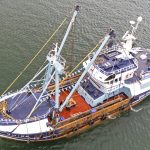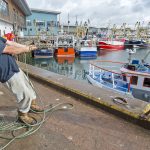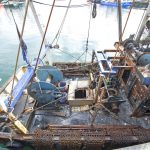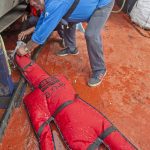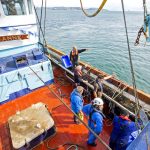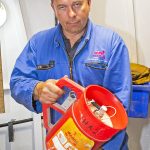The purpose of this feature is to show at first-hand how the Maritime and Coastguard Agency (MCA) works alongside fishermen and boatbuilders to get their vessels approved, so crews can take them to sea knowing that they are in safe hands. John Periam reports.
Photos by Geoffrey Lee

The fire-damaged Peace and Plenty III BM 24.
Surveying vessels is not an easy task, and involves a lot of work and form-filling that, at times, can be interpreted by the vessel owners in the wrong way. The MCA surveyors are there to help and guide all parties involved, while at the same time offering real-time advice on working in all weathers, making sure that those onboard return safely at the end of a trip.
This feature is divided into two parts, the first of which is a series of questions to expand on the role of an MCA surveyor, put to principal consultant marine surveyor Roger Gee, who operates from the MCA Marine Office in Plymouth.
The second part is a hands-on report following Roger Gee and Charles Blyth, a graduate MCA surveyor, while they carried out contrasting inspections on three vessels, Peace and Plenty III BM 24, Sue-Ellen BM 211 and Holly Anne BM 128, in Brixham harbour. This was made possible by the full co-operation of the owners and skippers, who gave approval for Fishing News to go onboard and take photographs of the MCA surveyors working.
Roger Gee
Before joining the MCA, Roger Gee worked for a classification society, DNV GL (Det Norske Veritas), which has a large presence in the oil and gas industry. Part of its remit is to certify ships and offshore structures on behalf of flag states.
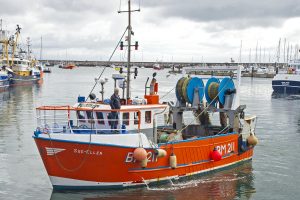
Sue-Ellen BM 211.
“I went offshore to tankers, semi-submersible rigs and floating production storage and offloading (FPSO) vessels.
“I had many fascinating and interesting experiences – landing by helicopter on the world’s smallest FSPO, while feeling the heat from the flare stack, is something that you’ll never forget. Likewise, undertaking a ‘tank’ inspection in the cross-braces of a semi-sub does concentrate the mind!
“DNV GL also has a presence certifying the large pelagic fishing boats which operate out of Peterhead, Fraserburgh and Shetland. Previously, I worked with the MCA out of Aberdeen, which gave me an insight into the workings of these ports, including the ship lifts, which are unique in the UK. These are where all the trades are available around the slipways. You could spend all day going from one vessel to another in various states of a survey.
“In life, one’s learning curve plays an important part, and this is where I learnt how to do this job, on vessels of all sizes and types. Fishing boats provide a unique service, and even today, skippers from the south coast routinely take their vessels to the North East of Scotland because of the type of service they receive there.”
The role of an MCA surveyor

Holly Anne BM 128.
Q&A with Roger Gee, MCA principal consultant marine surveyor
Fishing News: When, and how often, do fishing boats need to be surveyed?
Roger Gee: Fishing vessels are arranged into three distinct categories: under 15m, 15-24m, and over 24m. The survey arrangements are different for each category:
- Under-15m fishing vessels are seen once every five years, and usually in the water
- 15-24m fishing vessels are seen every 2.5 years, in and out of the water
- Over-24m fishing vessels are on a four-year survey cycle, with annual surveys, an intermediate survey at two years and renewal at four years.
All surveys include an element of emergency preparation, with drills conducted and witnessed at the main surveys. The larger vessels are often seen by external bodies (classification societies) in addition to the MCA.
Fishing News: What are the key points you are looking for?

Roger Gee, principal consultant marine surveyor at the Maritime and Coastguard Agency (MCA).
Roger Gee: The most important thing for us is the safety of all fishermen while at sea, and therefore the key points we look for ensure that the operation of the vessel, and the environment onboard a fishing vessel, are safe. This encompasses every aspect of the vessel – integrity of the hull, stability and response of the vessel in the water, the safety and emergency equipment, and the welfare of those onboard.
Our coastguards deal with the often tragic raw end of fishing tragedies, and as surveyors we feel that too.
I personally remember Fishing News producing an article about 12 years ago following the loss of a trawler in the Thames. It highlighted the devastating consequences for the family left behind – because the person was never found. The recent ILO 188 introduction aims to address that by the mandatory wearing of PFDs.
As surveyors, we look to ensure that the vessel, the skipper and the crew are sufficiently equipped to return from a fishing trip – every time, because even one loss of life is one too many.
Fishing News: When you survey a boat hull, what do you look for?
Roger Gee: A well-presented vessel! Like with many aspects of life, first impressions matter.
If a vessel looks poorly maintained, or if its fishing gear is clearly not cared for, then it may be a good indication that other aspects of the vessel may not be to the best of standards either.
Just walking onto the vessel will tell you a lot about how the vessel will respond, and whether there may be an issue with stability. The response of the vessel (in the transverse direction) is really important – does it move freely, or is there a slow response?
We look at everything – but the depth of survey will depend on why we are attending. For example, hull and machinery surveys will take place less frequently than surveys of safety equipment. On smaller vessels, all surveyors pay particular attention to seawater valves and pipework, engines, shafting and steering assembly. Often, the engineering resources and expertise to support the smaller vessels may not be as available as that for larger fishing vessels.
Clean bilges! Why? One of my first surveys of a cargo ship in dry dock had a hole in the bottom of it. It was caused by the jet-wash on the outside removing a small section of plate, which had rotted due to a collection of engineer’s tools. A very close call indeed.
Fishing News: Do you get involved in new fishing boat designs, and if so, do you work in liaison with Seafish?
Roger Gee: We work closely with Seafish in many forums, and we meet with its technical experts and new-build surveyors on a regular basis. A lot of its safety messages are ours too. There is good interaction here, particularly in areas of new and evolving technology. We all learn from our experiences, and we do share these to improve, and create a higher level of safety. Seafish and the MCA are both members of the Fishing Industry Safety Group (FISG), which meets on a regular basis with other member organisations to ensure that all are working together to support the fishing industry in a positive way.
Fishing News: Do you work with the manufacturers of safety equipment to make sure it is fully evaluated prior to the MCA recommending it?
Roger Gee: All safety equipment should be to a defined standard – this is normally called the ‘wheelmark’, which is the sign of the Marine Equipment Directive (MED). It ensures that the safety equipment has undergone significant and appropriate testing, so that, when it is needed, it does what the fisherman expects. Many years ago, we had a piece of equipment that claimed it was a life raft. On the occasion that it was needed, it partially inflated and then failed. This particular item was not MED-approved, and fortunately, such cases are now extremely rare.
Fishing News: Should all skippers use SafetyFolder applications to keep all their documentation together, so all crew members know where it is?
Roger Gee: SafetyFolder.co.uk is an excellent app that is free and available for all fishermen. It can take the stress out of proving compliance, because it is so intuitive. The ability to store certificate details and expiry dates of equipment, and to generate risk assessments, is a real bonus, and can save valuable time in the long run.
Fishing News: Do you encourage your surveyors to talk to fishermen about safety, and what to look out for?
Roger Gee: Being a surveyor is all about communicating. We are looking at not only the physical aspects of the vessel, but also the human interaction. Every time we attend a vessel, we will reinforce the safety message, and this will be different for every vessel. Skippers and their crews should be undertaking regular drills in emergency scenarios when the MCA is not around.
The importance of drills and crew training in saving life was highlighted in the recent rescue of Reegan Green.
The crew of Emilia Jayne had done a routine practice emergency drill just the week before, and this helped them enormously when Reegan went overboard back in March. They knew exactly what to do, remained calm throughout the process, issued a distress alert and a Mayday broadcast, and threw smoke markers and a life ring.
Of course, Reegan was wearing his lifejacket, which played a huge part in that, but the crew were able to spot him in the water and keep their lights on him until the helicopter winched him out of the water. There is no doubt that the drill helped everyone onboard to know exactly what to do, and the part that they should play. It’s a perfect example of why we encourage all vessels to undertake drills, through action or discussion, or when new crew appear onboard.
We also encourage crew to not walk past critical pieces of equipment without trying the safety features – these are not put in place for the MCA. They are there for the skipper and crew, and they need to work just as well at the end of the fifth year as they did on day one.
Fishing News: Do you make sure that information on radio links, etc, is visible in printed format by receivers, in case of an emergency?

The SafetyFolder app, on a hand-held device, lets you manage all your documents.
Roger Gee: Radio equipment features as a survey item at every main survey. We will test it, and ensure that the skipper is aware of how it works. Every owner should receive the GMDSS emergency procedures card. However, VHF DSC is often underutilised and misunderstood, with skippers not realising its lifesaving benefits – especially in a man-overboard situation. The immediacy of response from HM Coastguard through the simple press of the DSC button ensures that contact is made in a situation requiring a fast and accurate response. It means they can accurately pinpoint your location, and saves vital minutes on a response time in an emergency situation.
Fishing News: Do you look for the right places to have safety equipment onboard, visible for all crew members?
Roger Gee: Fifteen years ago, it was not uncommon for safety gear to be stored in accommodation areas, hidden away and forgotten. There is a much greater awareness that this approach is not going to save a life, and if it is going to be of use, it needs to be near the muster point/wheelhouse. Fire drills, abandon-ship drills and man-overboard drills are a great way of highlighting the deficiencies of keeping safety equipment in the wrong place.
Speak to fishermen who have had something go badly wrong at sea, and invariably, they will tell you the speed at which it does go wrong. Our coastguards will also reaffirm that when things go wrong, they go wrong fast. There is so little time to react. It pays to be prepared, and to prepare for the worst. That’s why it’s so important to alert the Coastguard the minute things start looking troublesome. You can never get time back. It makes sense to alert the Coastguard so they can keep an eye on a developing situation. Everyone has a role to play in keeping your crew safe. Always be prepared for ‘what if?’
Fishing News: Do you go to sea on any inspections to check things out?
Roger Gee: We will often go to sea on vessels, particularly for drills, and sometimes for verification of steering gear/machinery response. Anchor drills are now a requirement, and this will often be done just out of harbour limits.
Fishing News: What is the average length of time to do a survey?
Roger Gee: There is no average. We spend the time that is required to ensure the vessel is to the required standard. We spend a lot of time bringing the latest changes to the attention of fishermen – especially on smaller vessels, which often don’t have the resources that the larger vessels have. It’s very important to us not to work to a time limit – safety is the priority, not clock-watching.
Sue-Ellen BM 211

Roger Gee explains the results of the roll test to Sue-Ellen owner Graham Perkes and skipper Garry Roberts.
The 11.93 stern trawler Sue-Ellen BM 211, built at Truro by Steelship in 1985, was the second vessel that the MCA surveyors inspected. The vessel’s owner, Graham Perkes, had requested guidance from Roger Gee on replacing the trawl gantry aft and changing the mode of fishing to beam trawling.
Roger arranged to move Sue-Ellen to a more suitable mooring to take some measurements, while performing a basic fishing vessel roll test, with skipper Garry (Taff) Roberts in charge. The roll test is one of a selection of ‘tools’ available to owners/skippers that can give an indication of the stability of their vessel.
Conducting a roll test
- Measure the maximum beam at deck height of the vessel.
- Attach a rope to secure part of the vessel, ideally at some height off the deck.
- Have someone pull the rope to start the vessel rolling. Once it’s rolling sufficiently (making sure the temporary mark amidships is visible), start timing after one roll has passed.
- It is not important whether the roll is timed from the top of the roll, or either side of the roll when the boat passes upright (or at the lowest point of side). Time five complete rolls (one complete roll is from the start point all the way back to the start point – ie, if measuring from the top, rolling to one side, back through the top, over the other side, and back again).
- Repeat this process two more times, to give 15 timed rolls (in three sets of five). Take the time for the 15 rolls and divide this by 15, to give the average roll time in seconds.
- If the time for one average roll in seconds is less than the beam of the vessel in metres, the vessel can be said to be stiff. If the time in seconds is more than the beam of the vessel in metres, the vessel is said to be tender.
Following the roll test on Sue-Ellen, the owner and skipper were advised by the MCA surveyors that, in its current condition, the vessel was compliant, and that by having a lighter gantry and fishing gear fitted, the vessel should perform better. The changes to the mode of fishing were approved, and the boat could be lifted out for the work to be carried out.
A table of weights on/off will need to be maintained during the refit, and the vessel will need to be retested in its loaded condition when completed.
Peace and Plenty III BM 24
The first vessel of the day was the 11.73m beam scalloper Peace and Plenty III BM 24. Built in Swansea in 1983 as Ocean Star SA 104, the vessel first came to Brixham in 1988. It operated from there for around 20 years, before being sold to the southeast coast for a while, and returning to Brixham a couple of years ago.

Peace and Plenty III owner Ben Squire discusses the damage with Roger Gee.
Earlier this year, Peace and Plenty III caught fire while on passage back to Brixham for a refit, after a period working from Plymouth (Fishing News, 9 May, ‘Fire skipper ‘did all the right things’’).
The vessel was recently purchased by Ben Squire of Oceanic Drifter Ltd, to rebuild it and return it to fishing after the wheelhouse and deck areas were engulfed by fire.
It is standard practice after a major incident to issue a Preventative Detention Notice. This allows the owner and the MCA to visit the vessel, confirm its condition, and plan what is going to happen next.
In this situation, the plan was to get Peace and Plenty III out of the water, and to do some tests to see if the hull structure had sustained any structural damage due to the high temperature associated with the fire.
Before this could be done, Peace and Plenty III had to be made safe for towing to its maintenance facility. The owner had to make sure all windows, doors, hatches, freeing ports and gear were made safe, or removed, before the vessel could leave.
A conditional Load Line Exemption is issued for a restricted period. The survey provides confidence that the vessel can be expected to make its destination without becoming a hazard to shipping or port infrastructure.
Holly Anne BM 128
The third vessel was the 28.15m beam scalloper Holly Anne BM 128, co-owned by Sean Irvine and John Denbow of JFD Trawlers Ltd.
Built in 1968, the steel-hulled Holly Anne BM 128 is skippered by Steve Trust, and fishes with a crew of six. The MCA surveyors needed to check if previous findings had been rectified, and to complete a full check of the vessel, including MOB and anchor drills.

Holly Anne’s crew carry out an anchor drill.
Health and safety play a major part in their surveying duties, so they are required to wear the correct attire for the tasks ahead. This includes overalls, high-vis jacket, safety boots, hard hat, ear defenders, PFD, and a Dräger X-am 2500 gas meter, which detects a selection of combustible gases and vapours. Unfortunately, within the past 12 months, there have been several serious incidents on UK fishing vessels due to oxygen depletion.
Every four years, Holly Anne undergoes a renewal survey in order for it to receive an International Fishing Vessel Certificate. The survey requires it to be taken out of water, machinery to be opened up, a stability assessment to be completed, and a lifesaving and fire equipment check, and emergency drills, to be undertaken. It is important that crew members are involved, so that the MCA surveyors go through the scope of the survey in detail with them.
On leaving its berth with skipper Steve Trust at the helm, the vessel’s navigation equipment, including radar, plotters, autopilot and steering, were checked. After this, Holly Anne left harbour, before the crew, all of whom were wearing PFDs as per ILO 188, were put through a man-overboard (MOB) drill.
A water-filled dummy was thrown into the water in order to test the vessel’s procedures, crew and MOB equipment. At the same time, the surveyors gave the order to deploy the anchor from the deck overboard, making sure the crew knew how to do this.
Returning to Brixham an hour later, Roger Gee gave a briefing to those involved, reminding them that this routine must be carried out on a monthly basis.
The next stage was to evaluate fire drills with Dave Passmore of Protec-Fire (Brixham). Included in this was the use of self-contained breathing apparatus (SCBA) with compressed air cylinders. While this was taking place, Charles Blyth checked the vessel’s survival equipment (PFDs, flares, life rafts, life buoys and first aid packs), all of which need to be regularly serviced, with dates showing.
Working below deck plays an important part in fishing. All emergency lighting was tested, ensuring that power supply was available from both generators. Smoke and heat detectors were tested, and confirmed to be linked to the relevant sirens. There is a lot of difference in finding one’s way around when in darkness, and the availability of luminescent signage was important.

Holly Anne’s crew practise an MOB drill, with Roger Gee watching over the proceedings.
Holly Anne’s fuel tanks were checked for contamination, along with the condition of the steel for any signs of metal fatigue. After this, the cold storage rooms were given the once-over, checking the lower and upper sensors of the bilge pumps to see if they were operating correctly.
The engineroom emergency cut-off valves were checked, along with any visible spills or leakages, as well as the exhaust manifolds and relevant control panels.
Once the survey was over, Roger Gee and Charles Blyth wrote up their findings, and went through the vessel’s certificates and legal documents with Sean Irvine. Sean was also given the new official logbook. This is required to be completed by the skipper of vessels of over 16.8m, so that any incidents with the crew, accommodation, or any other associated vessels are documented, if needed as evidence in any legal case.
Any issues raised were discussed, and plans were made for them to be sorted before the final inspection clears Holly Anne to return to fishing (which was more a matter of formality).
Help and support
This feature illustrates the fact that MCA surveyors are there to help, and not to obstruct fishermen in their daily tasks. Roger Gee and Charles Blyth are highly respected professionals with a wealth of experience behind them. They are there to make sure that a vessel is safe and secure, that the crew is fully trained, and that their welfare is looked after under ILO 188.
Setting up this feature would not have been possible without the continued support of the MCA media team at Southampton, together with the skippers, owners and crews of the vessels involved.


… emergency stop button works on the winch.





